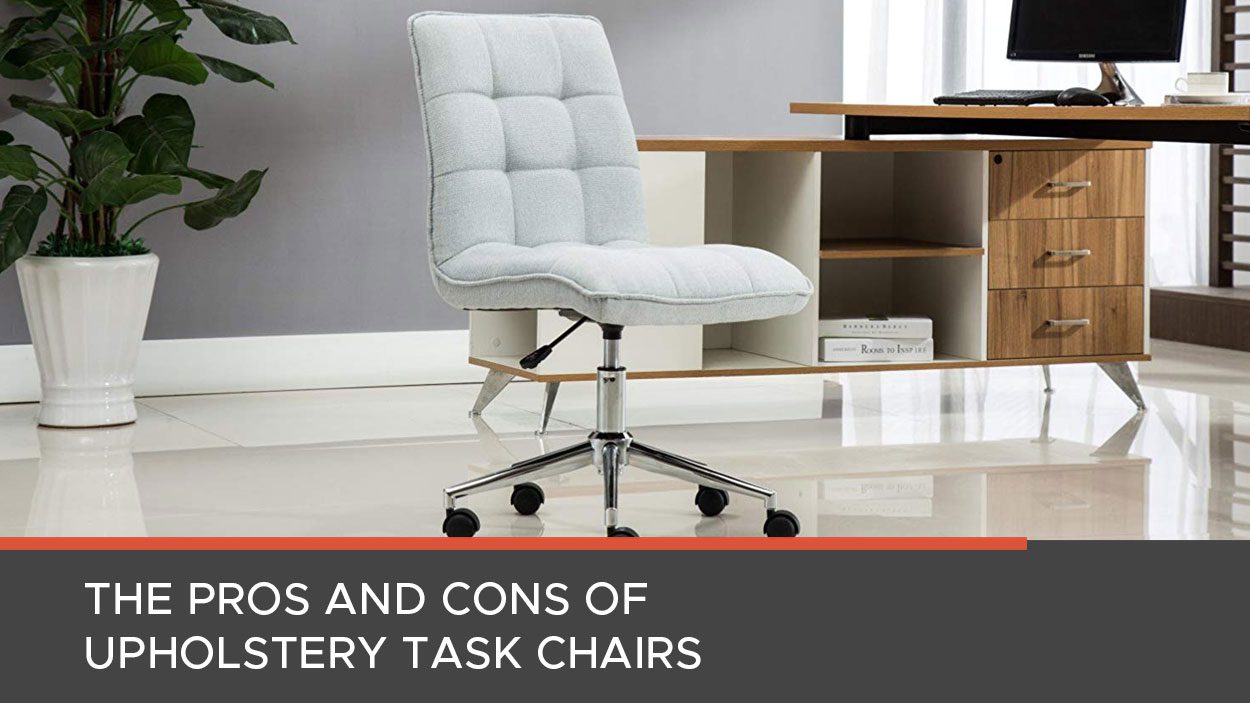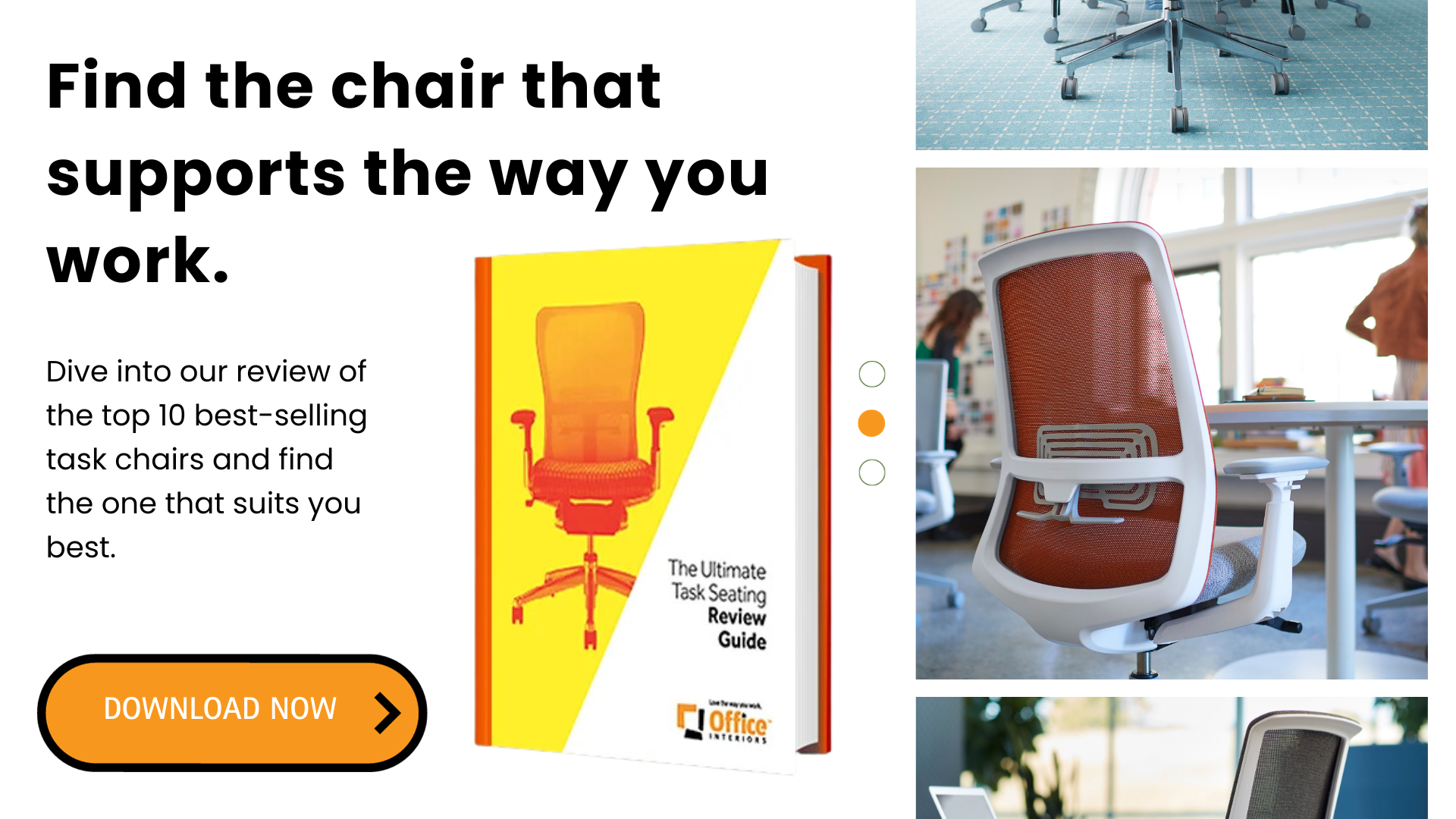When designing a new office, it’s essential to select the right chair. Productivity can dramatically go down when you aren’t comfortable.
According to a recent study, the average worker will spend 1,700 hours a year in front of a computer screen and sitting in that chair. In this guide, we’ll be looking at one of the most common materials found on task chairs – upholstery.
We’ll look at the pros – those that make upholstery chairs so appealing in the office. We’ll also look at the cons, which are the common reasons why office managers replace upholstered chairs.
What is an Upholstered Task Chair?
Today, upholstery is the most common material used for task chairs. Also colloquially referred to as a fabric chair, upholstery includes all the materials you find in the chair – the outer fabric as well as the padding and springs on the inside.
In the past, upholstery included materials like hay and wool, or even horsehair. Today, most upholstery chairs use metal springs for durability and foam for comfort. Selecting the right fabric and material is critical for the design and strength of the chair, which is why many offices still rely on upholstery.
A classic leather will provide a high-end look, but it may not age well. The leather will require maintenance, or it will start to crack. A modern mesh will provide initial airy comfort, but it may sag over time.
Selecting a New Task Chair
Depending on your needs, it is hard to go wrong with an upholstery chair. For many users, a fabric chair provides the best mix of style, comfort, and durability. However, an upholstery task chair is not for everyone. This list of pros and cons of upholstery task chairs will help you as you select your office furniture.
The Pros of an Upholstered Chair
There is a reason upholstery is still one of the most popular finish choices for office task chairs. It gets the job done in these three key areas:
Comfort
By combining modern foam with the durability and support of a metal spring system, the upholstery task chair can meet the needs of the pickiest office worker. Many users can only find comfort with the sure and even support of a fabric task chair.
The thick and durable build of the chair also lets the designers get creative with comfort. Adjustable lumbar supports can be hidden in the foam. Varying foam thickness provides pinpoint support where it is needed, and a little extra give where it is not. Designers also no longer must rely on materials like foam, wool, and horsehair. Modern materials and high-end foam material increase comfort.
Durability
The thick design and robust spring system make the upholstery task chairs one of the most durable on the market. The foam can support stronger springs and a more substantial support system, and the design of fabric can accommodate a heftier construction.
Design Options
With the wide variety of fabrics and designs on the market today, your options for designing the perfect task chair for the office are almost limitless. You have a wide choice of colours. Fabric and pattern options are also easy to find. Third-party fabric vendors can sometimes be used to source a broader range of designs and colours.
The Cons of an Upholstered Chair
Almost all the downsides to using an upholstered chair are direct tradeoffs of the upsides of using an upholstered chair. Here are the three that most commonly cause complaint:
Heat and Breathability
Unlike a mesh chair, the thick seat and foam padding won’t let air pass freely. This means your legs and back will get hot and sweaty during long work sessions. This can also lead to annoying odours being trapped in the chair if you aren’t doing regular maintenance on the seat. Some users find themselves continually shifting to relieve hot spots.
Maintenance
Almost every worker drinks coffee in the office. That can be a danger with an upholstery chair. Depending on the fabric used with the chair, a single spilled coffee can lead to a permanent stain and an annoying, permeating odour. Fabric cleaning materials can help, but if the drink makes it to the foam interior, you may need to replace the seat to eliminate the odour.
Weight
Metal springs and a thick build will make your chair durable, but it will also make it heavy. Moving the chair in the office may not be a one-person job, especially if you need to get around a tight corner. Additionally, lifting the chair can be a surprisingly strenuous work if you aren’t careful.
A Final Word on Upholstered Task Chairs
For comfort and design, there may not be a better option for your office than an upholstery task chair. That said, maintenance and upkeep may be required to keep your chair in tiptop shape.
As you can see from the pros and cons listed above for upholstery task chairs, there is a lot to love about these chairs. For many, they are a classic that continues to be popular. We see no reason why that popularity might wane in the foreseeable future.
Are you ready to find the perfect chair for your office? Read our comprehensive task chair reviews!
Cory Porteous
Director of Marketing & Inbound Business Development
Office Interiors




